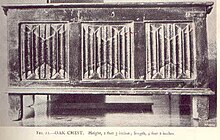Linenfold
This article needs additional citations for verification. (March 2023) |


Linenfold (or linen fold) is a simple style of relief carving used to decorate wood panelling with a design "imitating window tracery",[1] "imitating folded linen"[2] or "stiffly imitating folded material".[3] Originally from Flanders, the style became widespread across Northern Europe in the 14th to 16th centuries. The name was applied to the decorative style by antiquarian connoisseurs in the early 19th century; the contemporary name was apparently lignum undulatum (Latin: "wavy wood"), Nathaniel Lloyd pointed out.[4]
Wood panelling or
The simplest linenfold style is "parchemin" (also known as "
folded in half and then spread out with the sharp centered fold running vertically, and the top and bottom running out to the corners of the panel, with something of the appearance of an opened book. This style of linenfold can be created using a plane and a pre-drawn pattern, with a little finishing chisel work required at each end. A stitched embroidered border could be counterfeited by the use of punches. More complicated styles resemble a sheet of fabric that has volute folds back and forth many times. Linenfold might be fielded, visually complete against a flat panel surface and contained within each panel, or it might provide the appearance of a continuous linenfold passing behind the stiles of the framing.Carving linenfold decoration requires basic carving skill, the creased designs were run with a round plane; only top and bottom edges needed to be finished with a gouge. Significantly, linenfold had no prototype in architectural practice:[6] the technique of the round scraper plane is also applicable to softer stone-cutting.
Regional variations quickly developed in
Notes
- ISBN 0-397-47302-8. Page 72.
- ^ Fletcher, Banister. A History of Architecture on the Comparative Method. Scribner, 1961. Page 1266.
- ^ Wight, Jane A. Brick Building in England from the Middle Ages to 1550. J. Baker, 1972. Page 423.
- Burlington Magazinefor Connoisseurs 53 No. 308 (November 1928), pp 230-37.
- ^ A directive of Henry III for "Norway boards" to "wainscot" the chamber of the prince Edward at Winchester was noted by Nathaniel Lloyd 1928:230.
- ^ John Gloag, A Short Dictionary of Furniture, rev. ed. 1969: sub "Linenfold"
- ^ Encyclopædia Britannica, 15th ed. Article "Decorative Arts and Furnishings", section "Middle Ages" (by Joseph T. Butler, online).
